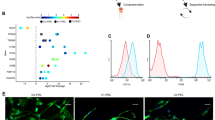Abstract
Microglia are immune cells of the central nervous system (CNS), which play an instrumental role in eliminating invading pathogens and help regulate localized inflammation. They also assist in maintaining homeostasis of the brain microenvironment. Microglia isolation from primary brain tissue can be difficult with poor yields from tissue dissociation which precludes many downstream assays from being efficiently conducted. Recovery of intact microglia for single-cell or next-generation RNA sequencing (NGS, RNAseq) can be a difficult process. The recovery of intact RNA transcripts inside viable cells has its challenges. Here we describe a method to enrich CD11b + microglial cells from brain tissue followed by FACS, for a reliable and reproducible method for the recovery of high-quality RNA from sorted microglia for downstream sequencing.
Access this chapter
Tax calculation will be finalised at checkout
Purchases are for personal use only
Similar content being viewed by others
References
Hoeffel G, Chen J, Lavin Y et al (2015) C-Myb(+) erythro-myeloid progenitor-derived fetal monocytes give rise to adult tissue-resident macrophages. Immunity 42:665–678
Aloisi F (2001) Immune function of microglia. Glia 36:165–179
Prinz M, Tay TL, Wolf Y et al (2014) Microglia: unique and common features with other tissue macrophages. Acta Neuropathol 128:319–331
Ginhoux F, Greter M, Leboeuf M, Nandi S, See P, Gokhan S et al (2010) Fate mapping analysis reveals that adult microglia derive from primitive macrophages. Science 330:841–845
Ransohoff RM, Perry VH (2009) Microglial physiology: unique stimuli, specialized responses. Annu Rev Immunol 27:119–145
Kim SU, de Vellis J (2005) Microglia in health and disease. J Neurosci Res 81:302–313
Gosselin D, Link VM, Romanoski CE et al (2014) Environment drives selection and function of enhancers controlling tissue-specific macrophage identities. Cell 159:1327–1340
Lavin Y, Winter D, Blecher-Gonen R et al (2014) Tissue-resident macrophage enhancer landscapes are shaped by the local microenvironment. Cell 159:1312–1326
Kreutzberg GW (1996) Microglia: a sensor for pathological events in the CNS. Trends Neurosci 19:312–318
Chinnery HR, Ruitenberg MJ, McMenamin PG (2010) Novel characterization of monocyte-derived cell populations in the meninges and choroid plexus and their rates of replenishment in bone marrow chimeric mice. J Neuropathol Exp Neurol 69:896–909
Prinz M, Erny D, Hagemeyer N (2017) Ontogeny and homeostasis of CNS myeloid cells. Nat Immunol 18:385–392
Giulian D, Li J, Bartel S, Broker J, Li X, Kirkpatrick JB (1995) Cell surface morphology identifies microglia as a distinct class of mononuclear phagocyte. J Neurosci 15:7712–7726
Holtman IR, Raj DD, Miller JA et al (2015) Induction of a common microglia gene expression signature by aging and neurodegenerative conditions: a co-expression meta-analysis. Acta Neuropathol Commun 3:31
Nikodemova M, Watters J (2012) Efficient isolation of live microglia with preserved phenotypes from adult mouse brain. J Neuroinflammation 9(147):1–10
Bennet ML, Bennet FC, Liddelow SA et al (2016) New tools for studying microglia in the mouse and human CNS. Proc Natl Acad Sci U S A 113(12):1738–1746
Author information
Authors and Affiliations
Corresponding author
Editor information
Editors and Affiliations
Rights and permissions
Copyright information
© 2022 Springer Science+Business Media, LLC, part of Springer Nature
About this protocol
Cite this protocol
Doty, A.L., Oliveria, A. (2022). Microglial FACS for Robust RNA Recovery for Next-Generation Sequencing. In: Deleyrolle, L.P. (eds) Neural Progenitor Cells. Methods in Molecular Biology, vol 2389. Humana, New York, NY. https://doi.org/10.1007/978-1-0716-1783-0_7
Download citation
DOI: https://doi.org/10.1007/978-1-0716-1783-0_7
Published:
Publisher Name: Humana, New York, NY
Print ISBN: 978-1-0716-1782-3
Online ISBN: 978-1-0716-1783-0
eBook Packages: Springer Protocols




